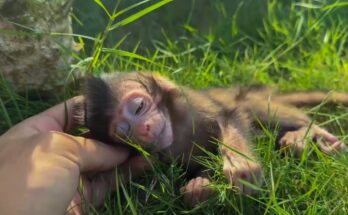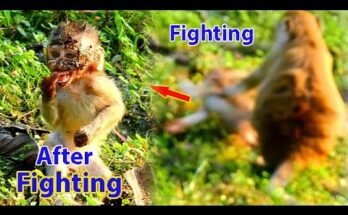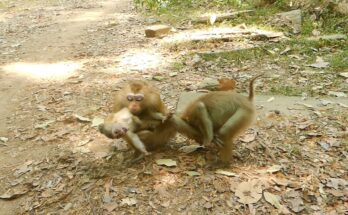In a heartbreaking and shocking turn of events, the peaceful environment of the monkey sanctuary was suddenly disrupted by an unexpected and aggressive attack. The title “Why So Violent? Monkey’s Unexpected Attack on Orphan Dustin Explained” sheds light on a moment that left many viewers disturbed and deeply concerned for little orphan Dustin, a baby monkey who has already endured a painful journey after losing his mother.
Dustin had been adapting slowly to his new life in the sanctuary, trying to bond with the other monkeys. He was known for his calm and gentle nature, always seeking warmth and safety in his new surroundings. Sadly, that peaceful routine was shattered when an older monkey launched a sudden and unexplained attack on him. The scene was alarming—Dustin’s tiny frame overwhelmed by a stronger, more dominant monkey. He cried out in fear and pain, desperately trying to escape the grasp of his aggressor.
But what triggered this violent behavior?
This video offers a detailed and compassionate explanation of what may have caused such aggression. Experts believe several factors could be responsible. First, the social hierarchy among monkeys can be extremely complex. Older or dominant monkeys sometimes feel threatened by new arrivals, especially when they receive attention or food from caregivers. Orphan Dustin, though harmless, might have unintentionally triggered jealousy or territorial instincts.
Secondly, monkeys that have experienced trauma or unstable pasts may react unpredictably. The attacker might have unresolved behavioral issues or emotional scars, causing them to lash out during moments of stress or competition.
The video also dives into body language before the attack, slow-motion analysis of the incident, and responses from sanctuary staff. Viewers will see how caretakers responded immediately to protect Dustin and separate him from further harm. The team rushed in, treating Dustin’s minor injuries and calming the frightened baby monkey with care and affection.
Importantly, this video also highlights what steps are being taken to prevent such incidents in the future—introducing gradual introductions, monitored playtime, and behavioral assessments for all monkeys in the sanctuary. By understanding the root of aggression, caretakers can create a safer environment for vulnerable orphans like Dustin.
While the footage is difficult to watch, it serves an educational purpose. It reveals the challenges involved in rehabilitating and caring for rescued animals, especially those with past trauma. Monkey behavior, like human behavior, is influenced by environment, history, and social dynamics.
Dustin’s story reminds us of the resilience of orphaned animals and the importance of compassion, patience, and proper care. As the video concludes, viewers will find hope—Dustin, though shaken, begins to recover in a safe, quiet corner of the sanctuary, surrounded by loving staff and slowly learning to trust again.
Don’t forget to like, comment, and subscribe to support Dustin’s journey and the rescue efforts that continue to give monkeys like him a second chance at life.


